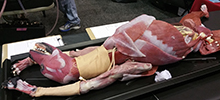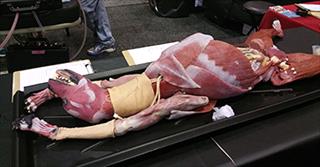Can veterinary students adequately learn surgical skills by practicing on fake patients?


Photo by Dr. Tony Johnson
The synthetic canine model designed by SynDaver Labs is intended to replace live animals and animal cadavers in veterinary surgical training. The company exhibited the dog in January at a conference by the North American Veterinary Community.
A new way to teach veterinary students to perform basic surgeries could eliminate the need to practice on live animals and cadavers.
Whether synthetic animal models are an adequate alternative to real patients is up for debate.
SynDaver Labs, makers of synthetic human cadavers and tissues used to train physicians and in crash testing, released last year a canine model that's now replaced the cadavers and live animals used by veterinary students at the University of Florida and Texas A&M University.
Veterinary medical students often learn to perform basic surgeries on live animals, typically sourced from local animal shelters. Patients are euthanized at the end of the procedures while still under anesthesia.
These terminal surgeries are a source of controversy. Since the 1980s, activists and students have questioned the ethics and necessity of sacrificing animals for teaching purposes. Growing concerns regarding the ethics of terminal surgeries have led schools to seek alternative teaching methods such as computer models and animal cadavers. However, books and computers, while providing step-wise instruction, cannot mimic the tactile experience of performing surgery or simulate the emotional pressure.
The use of cadavers — adopted by UF and other programs as a way to avoid sacrificing animals — also has limitations. Dr. Tony Johnson, an emergency and critical care specialist and consultant for the Veterinary Information Network, an online community for the profession, explained it this way: "Teaching a lab for veterinarians using defrosted cadavers is not only squishy ethics and esthetically unpleasant, [cadavers don't] handle like living tissue."
Learning to handle living tissue as a student is important given that new veterinarians can be expected to perform unsupervised surgeries on their first day in practice. Seeking to preserve the learning experience without sacrificing animals, UF academicians turned to SynDaver, based in Tampa, Florida. Drs. Stanley Kim and Brad Case approached the company to make an animal model that would reduce the experience gulf between performing procedures on teaching cadavers and live patients.
"We developed a list of things we wanted to be able to do with the unit," Kim said. "SynDaver took that list and came up with a prototype."
The resulting prototype allows students to perform exploratory surgeries and common abdominal procedures, including ovariohysterectomies and surgeries on the stomach, intestine and bladder.
SynDaver released the surgical canine in 2016 with the technology licensed to UF. Kim and Case are license-holders.
Shaking up the learning experience
Not all veterinarians are sold on the idea of learning critical surgical skills on a fake animal. A SynDaver press release in June 2016 provoked lively discussion on VIN message boards, where some veterinarians expressed doubts that clients would have a high level of confidence in new graduates trained solely or mostly on SynDaver models.
Other VIN members reflected on the ethical conundrum many students face, having to practice on and euthanize animals via terminal surgeries in order to learn how to save patients.
Dr. Laura Schurr, a 2015 graduate of Kansas State University, reflected on her surgical training in the VIN discussion: "We did two procedures in junior surgery, stood and watched a couple surgeries in surgical rotations (and if you were lucky got to suture a few things up and act as a human retractor). So I think this product could be beneficial to learn procedures, especially for visual learners who need to see or do it over read a book.
"But nothing teaches you like an actively bleeding patient on your own table," she stressed.
According to SynDaver, its canine replicas can do just that. Each dog model is made from a proprietary mixture of water, salts and fibers that allow it to bleed and be customized to mimic multiple diseases and conditions, providing students with experience in real-world pathologies. SynDaver lists 30 procedure options for the surgical canine and is working on organ modules for conditions such as pyometra and diaphragmatic hernia, according to Dr. David Danielson, the company's vice president of veterinary technology.
"We focused initially on the procedures I call my nightmares [such as a ruptured spleen that can cause a patient to bleed to death]," he said. "Now we are focusing on pathologies for advanced learning, such as teaching surgical residents."
Veterinarians emphasize that surgery does not always follow a textbook; a surgeon must learn to navigate complications. In live-animal surgery classes, students can't count on experiencing complications with a dog that bleeds excessively or an ovarian stump that slips. In cadaver-based labs, excessive hemorrhaging is nonexistent.
But SynDaver canines can simulate real-life surgical complications, Danielson said. He described a surgery class at UF, where the SynDaver canines have been in use since 2016. After students performed a routine spay, Danielson said the professor had them turn around while a proctor cut and dropped the ovarian stump, forcing the students to find and ligate it while the dog hemorrhaged.
Once a surgery is completed, the module can be reset. "[The organs] have different areas of interface; they are all replaceable," Danielson explained. For example, he said, after a student completes a spay on a synthetic dog, the instructor can insert a new reproductive tract and fasten the skin plate. Other organs can be reused. "You can do multiple biopsies on one liver lobe," he explained.
For neophyte surgeons, the realization that one is directly responsible for the life or death of a fellow creature can be a psychological hurdle. When asked how students respond to the skinless, furless dogs and whether the bleeding of a synthetic model accurately mimics the stress of operating on a pet, Danielson said the students he's observed take it seriously. "They were respectful. Some of them were nervous," he said.
Kim isn't entirely convinced that SynDaver teaching models, while "vastly superior" to thawed cadavers, can replace the experience students have training on live animals. "Regardless, [what] we do know is that surgical training using live animals is becoming very difficult to justify, and simulation technology is only getting better," he said.
Close, but not quite
Johnson, the VIN consultant, examined a SynDaver canine model during a recent veterinary conference and compared its synthetic tissues to those of an actual patient. "The fat feels like fat, muscle feels like muscle, ligaments feel like ligaments," he said, noting that the SynDaver dogs were "slightly more rubbery" than living tissue and a little less compliant.
"It's about 80 percent normal versus a defrosted cadaver, which is about 40 percent normal," he estimated.
There are other more significant differences. A condition not yet replicated in Syndaver's canine model is laryngospasm, the involuntary muscular contraction of vocal folds, restricting air flow into the lungs and posing an obstacle to intubation.
The technology exists to replicate laryngospasms and other movements such as breathing, swallowing and intestinal motion in the canine model. Making it a reality requires funding, Danielson said. "We would like to be able to mimic the motions of a dog under anesthesia or that has been hit by a car," he said, noting that UF and several other institutions have requested a dog that can emulate an animal in an emergency situation.
Cost is a hurdle for veterinary programs looking to implement the use of synthetic surgical animals. SynDaver's surgical canine with all organs costs $28,500. As the unit experiences wear, SynDaver offers a refurbishment package for $3,500 that includes a brand new set of organs. There also is a $15,000 abdomen module; pathological organs can be purchased separately.
"The surgical canine itself would last forever if treated appropriately," Danielson said, but organs often must be replaced after repeated uses. "We do offer a yearly refurbishment package where the dog is returned to us. Any damage to the core canine is repaired and any upgrades are included in the refurbished dog. In essence you get a new dog complete with a total set of new organs."
Attracting investors
Plans to expand SynDaver are under way. A 2016 crowdfunding campaign to further develop SynDaver's veterinary models fell short of its goal, but Danielson says the company is working with other organizations in the hopes of funding new species models and refining its existing canine model.
In an online invitation to potential investors, SynDaver Labs states that it "builds the world's most sophisticated synthetic human and animal bodies" for customers in medical and veterinary medicine.
"The company has also developed a surgical canine model that is now permanently in use at the University of Florida, Texas A&M and several other schools, where it has completely replaced the use of both live dogs and canine cadavers in surgical education programs!" the website states. "The company is already working on additional animal models including cat, horse and rabbit."
SynDaver aims to go public with a stock market launch planned for 2020. Right now, $50,000 is the minimum investment.